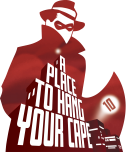AP2HYC: The most consistent thing in every story within Papercuts and Inkstains is the dark humor and sarcasm that is strewn throughout. Is that something that you consciously include in each story, or is that an element that is pretty much ingrained in your writing style and not something that you deliberately highlight in your work?
MS: I don’t think we can help it. I think the collaborative aspect really helps to bring out that side of our personalities. Much like when you are sat in the pub with friends you start to joke around, poke fun at the holes in what each other are saying, and out of these conversations humour finds its way into the stories. I think when you are working on something solo it can be incredibly easy to take things way too seriously. A fresh set of eyes in your world can often see the humour in something you are overlooking and help turn a lifeless world into something much more interesting. Also I think humour is a great way to present much more serious themes and slip them under the radar.
RJ: They do say that sarcasm is the lowest form of wit, which is great for Mike and I as it means we don’t have to work too hard to write it… But, more seriously, I think Mike summed it up best as a way of getting some more serious themes and undertones into otherwise farcical and whimsical stories. It all adds to the layers of the Papercuts onion.
AP2HYC: In addition to multiple writers, you have a bunch of talented artists who contribute to Papercuts and Inkstains. I’m curious as to how that relationship works. Comics are often initially thought of as a visual medium, and I wonder how involved you are where the actual aesthetics are concerned. Do you tend to have an idea as to what you wish to see and articulate it to your artists, or is it more of a blind faith situation where you have full confidence in letting the artists take control of their medium?
MS: Without the artists we are nothing but a bunch of idiots shouting at each other. We couldn’t do any of this without them. We try and make sure we tell them at every available opportunity that we have nothing but buckets of love and admiration for every single one of them. They have all been so patient, understanding, creative, and inspiring. The collaborative working aspect I would say is the thing I have enjoyed most out of the whole Madius experience. We have been lucky to work with a ridiculous amount of talented folks, and have made some amazing friends through collaborative creation.
When it comes to the control we have, the biggest influence we have is selecting the artist for the project. Whether that be someone we have already worked with or somebody new. This is something we take a great deal of care over as the visual aesthetic is critical to the success or failure of a story. Once we know who is working on a project, it is generally around working to their strengths and making sure they are happy and comfortable. Every artist likes to work slightly differently and we always try to make sure we keep things fun for anyone stupid enough to work with us. Some artists like very detailed scripts with layouts, others prefer for the script to just be bare bones and only include the critical storytelling elements. So there really isn’t an answer to that question; it varies tremendously from one end of the scale to the other.
Another factor is the story itself and how specific the details need to be for the story to work. I guess that’s a long way of saying, every story and every artist is different. When it comes to trust and confidence in the artist, we have complete faith; otherwise, we wouldn’t have approached them with the script. We are always open to suggestions and revisions to stories, and try and make sure we aren’t precious. Artists can see things in ways we were completely missing and bring unique ideas to the table, we like to think that a story isn’t finished until the final pages are lettered and see the whole creation process as a fluid thing.
RJ: I think again, to echo Mike, the element we want to bring most to our stories is fun. Fun to write, fun to read, fun to draw. We do stick our heads together with the artists we work with to enable them to get their input into things. Take Rory Donald in “Cast Adrift”, his visuals, the viewpoints and angles of panels and his emphasis on shadow really added an lovely visual aid to the sense of menace we had wanted to build up in that story. That’s all Rory. Taking our script and making it something better, enhancing it, evolving it into a bigger beast. Same could be said with Dan Butcher in “FPS”.
He took a script written entirely from the fixed perspective of a soldiers helmet and made it this JJ Abrams inspired, close, tense fight scene with a nice little payoff at the end. You can’t write in an artist’s keen eye or their ability to take a particular scene and give it life. We’ve been incredibly lucky to have worked with the people we have so far, we’re incredibly lucky to be working with even more talented people on Papercuts 4, 5, 6, and 7… (SPOILER ALERT… Yes we are that far ahead…)


